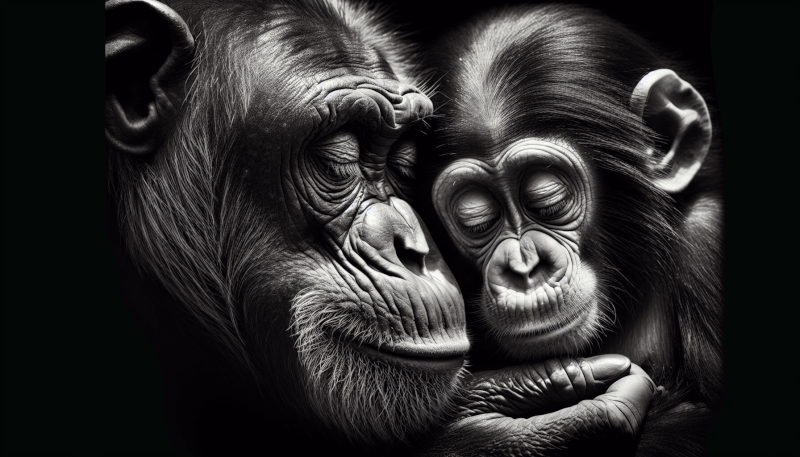In the fascinating world of primates, emotions run deep and social bonds shape their intricate interactions. From chimpanzees and gorillas to lemurs and monkeys, these incredible creatures navigate their lives with a wide range of expressions and connections. Whether it’s a tender grooming session, playful antics, or a comforting embrace, primates display a myriad of ways to express their emotions and form deep social bonds. By understanding the remarkable ways in which these animals communicate and connect, we gain invaluable insights into the essence of their lives and the complex nature of their social structures.

How Do Primates Express Emotions?
Primates, including humans, have a complex range of emotions that they express through various means. Facial expressions, vocalizations, gestures and body language, mutual grooming, and play behavior are all ways in which primates express their emotions.
Facial Expressions
Facial expressions play a crucial role in primate communication. Just like humans, primates can express a wide array of emotions through their faces. Happy, sad, surprised, angry, fearful, and playful expressions are all commonly observed in primates.
Similarities with Human Facial Expressions
Many primate facial expressions closely resemble those of humans. For example, a big grin with an open mouth often signifies happiness, while a furrowed brow indicates anger or confusion. These similarities suggest a common evolutionary origin of facial expressions across primates.
Nonverbal Communication through Facial Expressions
Facial expressions not only convey emotions but also serve as a nonverbal form of communication. Other members of a primate group can interpret these expressions and respond accordingly, promoting social interactions and maintaining group cohesion.
Examples of Facial Expressions in Primates
In chimpanzees, a wide smile with exposed teeth, often accompanied by laughter-like vocalizations, is a common expression of playfulness. Conversely, a chimpanzee baring its teeth with a pronounced brow ridge is often a sign of aggression or threat display.
Vocalizations
Vocalizations are another important means through which primates express their emotions and communicate with each other. Primate vocalizations can vary in pitch, duration, and intensity, conveying different emotions and messages.
Types of Primate Vocalizations
Primate vocalizations can be classified into various types, including calls, screams, grunts, hoots, and even songs. Each vocalization type serves a different function, ranging from warning calls to territorial marking to expressing emotions such as fear or excitement.
Function of Vocalizations in Social Interactions
Vocalizations in primates play a crucial role in social interactions. They help individuals locate each other, maintain group cohesion, warn of potential dangers, express emotions, and establish dominance or submission within the group.
Examples of Primate Vocalizations
Gorillas produce a variety of vocalizations, including low grunts, hoots, and roars. The chest-beating display performed by a male gorilla is not only a visual gesture but also accompanied by powerful vocalizations, expressing dominance and territorial claims.

Gestures and Body Language
In addition to facial expressions and vocalizations, primates communicate through gestures and body language. These nonverbal cues are essential for conveying emotions, intentions, and maintaining social relationships.
Role of Gestures in Primates
Gestures in primates serve various functions. They can be used to express submission, invite play, establish dominance, or convey comfort and reassurance. These gestures are an integral part of the complex communication system in primate societies.
Communication through Body Language
Primates use their entire body to communicate with each other. Posture, stance, and movements can convey emotions such as aggression, fear, or relaxation. For example, a relaxed primate may exhibit open body posture, while an aggressive primate may make itself appear larger and more intimidating through erect posture and aggressive movements.
Examples of Gestures and Body Language in Primates
Bonobos, known for their high level of social intelligence, use various gestures and body language to communicate. They may extend their arms to invite play, engage in synchronized movement to establish social bonds, or huddle together to express comfort and closeness.
Mutual Grooming
Mutual grooming is a behavior commonly observed among primates and serves as a means of expressing emotions and forming social bonds. Grooming involves one primate picking through the fur of another, removing parasites and providing social grooming benefits.
Importance of Mutual Grooming
Mutual grooming holds significant importance in primate societies. It helps maintain personal hygiene by removing parasites and keeps social bonds strong within a group. Grooming sessions also provide opportunities for individuals to express care and affection towards each other.
Formation and Maintenance of Social Bonds
Through mutual grooming, primates form and strengthen social bonds. By engaging in grooming behaviors, individuals demonstrate trust, intimacy, and cooperation, which are essential for maintaining a cohesive social group.
Benefits of Mutual Grooming
Apart from bonding, mutual grooming also has other benefits for primates. It helps reduce stress and tension, provides social support, and enhances social interactions within the group. Additionally, grooming can be used as a form of reconciliation after conflicts occur.

Play Behavior
Play behavior is not exclusive to humans but is also observed in various primate species. Play serves multiple purposes, including the expression of emotions, skill development, and establishment of social relationships.
Purpose of Play Behavior
Play behavior in primates has several purposes. It allows them to release pent-up energy, practice motor skills, and hone social and cognitive abilities. Play also serves as a way to explore and understand their environment.
Building Social Skills and Relationships
Play behavior is an important tool for establishing and strengthening social relationships among primates. Through play, individuals learn to cooperate, communicate, and establish dominance hierarchies within a group.
Examples of Play Behavior in Primates
Young chimpanzees engage in various forms of play, including wrestling, chasing, and tickling. These play sessions not only allow them to develop physical skills but also foster social bonds and teach them the rules of social interactions within their community.
How Do Primates Form Social Bonds?
Social bonds among primates are crucial for their survival and well-being. They form strong relationships through different mechanisms such as maternal relationships, sibling relationships, coalitions and alliances, dominance hierarchies, and mating and pair bonding.
Maternal Relationships
Maternal relationships are fundamental among primates. Mothers play a vital role in nurturing and protecting their offspring, ensuring their survival and healthy development.
Importance of Maternal Bonding
Maternal bonding is crucial for the well-being and survival of primate infants. It provides them with care, nourishment, protection, and socialization, setting the foundation for their future interactions and relationships.
Nurturing and Protecting Offspring
Primate mothers invest significant time and effort in nurturing and protecting their offspring. They carry them, provide them with breast milk or food, groom them, and teach them essential survival skills.
Long-Term Effects on Offspring
Maternal relationships have long-term effects on primate offspring. Strong maternal bonds contribute to the emotional and social development of the young, shaping their behavior and ability to form relationships with others.
Examples of Maternal Relationships in Primates
Orangutans exhibit strong maternal bonds, with female orangutans spending several years closely caring for their offspring. The young orangutans learn from their mothers and rely on them for protection and learning important survival skills.

Sibling Relationships
Sibling relationships are another crucial aspect of social bonding in primates. The interactions between siblings play a significant role in their social development and learning.
Sibling Rivalry and Cooperation
Siblings often engage in both rivalry and cooperation. Competition for resources, attention, and dominance may occur, but siblings also learn to cooperate during play and other activities, building essential social skills.
Learning and Social Development
Sibling relationships provide opportunities for learning and social development. Through interactions with their siblings, young primates learn social norms, communication, and cooperation, preparing them for their future interactions with other group members.
Examples of Sibling Relationships in Primates
In rhesus macaques, sibling relationships are evident from an early age. Young macaques engage in playful behaviors, such as chasing and wrestling, helping them develop physical coordination and social skills.
Mating and Pair Bonding
Mating and pair bonding are critical aspects of primate social structure, contributing to the formation of long-term social bonds and the successful reproduction of individuals.
Mate Selection
Primates engage in various mate selection strategies, including displaying physical attractiveness, performing courtship rituals, and engaging in vocalizations and displays to attract potential mates.
Formation of Pair Bonds
Pair bonding occurs when a male and female form a long-term relationship. This bond may involve cooperative parenting, mutual grooming, and exclusive mating, enhancing their chances of reproductive success.
The Role of Pair Bonding in Social Structure
Pair bonding plays a crucial role in primate social structure. It helps establish stable family units, promotes cooperation between mates, and contributes to the overall stability and cohesion of the primate community.
Examples of Mating and Pair Bonding in Primates
Gibbons are well-known for forming monogamous pair bonds. Males and females engage in coordinated vocal duets, swinging through the trees together, and share parenting responsibilities, forming a strong and lasting bond.
In conclusion, primates express their emotions through facial expressions, vocalizations, gestures and body language, mutual grooming, and play behavior. These expressions serve as important nonverbal communication tools, promoting social interactions and maintaining interpersonal relationships within primate groups. Social bonds are formed through maternal relationships, sibling relationships, coalitions and alliances, dominance hierarchies, and mating and pair bonding. These bonds are instrumental in ensuring the well-being, survival, and successful reproduction of primates, contributing to the complex social structure observed among these fascinating creatures.



